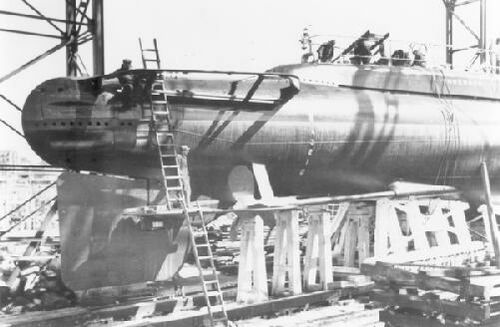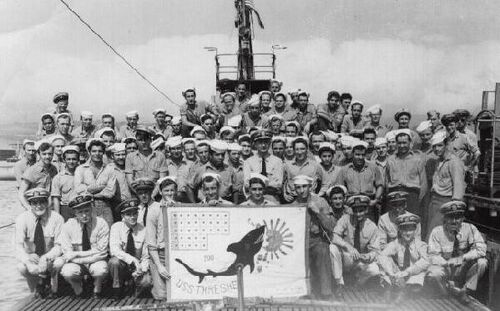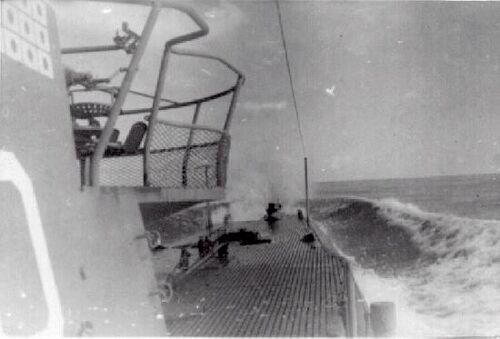200

Bruce A. Broseker contributed this photo. He is the grandson of Signalman 1st Class Bruce F. Lemmon, who made five war patrols on the Thresher during WW II. He maintains a nice website about the Thresher that can be seen at this link.
Photo courtesy of Bruce A. Broseker, whose grandfather made war patrols 11 thru 15 on the Thresher.

Thresher's stern as she sits on her building slip at the Electric Boat Company in Groton, CT., spring of 1940. The two "dimples" at the very stern are the shutter door for her two starboard side aft torpedo tubes. When the outer door to the tube is opened, these doors fold inward and the dimples provide a smooth exit for the weapon. This view also gives a good view of her rudder, stern diving planes, and propeller arrangement. The ventral location of these implements is an innovation that can be traced back to Simon Lake.
Photo courtesy of Bruce A. Broseker, whose grandfather made war patrols 11 thru 15 on the Thresher.

Thresher sliding down the ways at Electric Boat at Groton, CT. into the Thames River on March 27, 1940. The newspaper artists have used paint and ink to enhance some of the bunting on the bow of the submarine. Boats were launched in a relatively advanced state of completion during this time. That would change when the war started and the ways needed to be vacated so that another boat could be laid down.
Newspaper wire photo in the private collection of Ric Hedman.

A photo taken just after the one above, showing Thresher's slide into the Thames River, CT. on March 27, 1940. She is still resting on the cradle, but that would soon float free from under the boat and be recovered.
U.S. Navy photo courtesy of Bruce A. Broseker.

Thresher after her launch, sitting at the fitting out pier at Electric Boat, summer of 1940. Submarines are not launched 100% complete, and much work remains to be done before she can head to sea for the first time. An interesting feature in this photo can be seen on the edge of the forward deck, above the anchor. These folded up doors on the edge of the superstructure are covers for swing-out mine cable cutter arms. The arms are hinged at the forward end and will swing out and lock into place. They have sharp, serrated teeth on the forward edge that are designed to cut mine cables. Photographs of the rigged out cutters are extraordinarily rare, and even photos of the open doors are hard to find, making this a rare photo. The cutters were not popular with the sub's crew, as it is required that the boat be surfaced to rig them out, and no captain ever wanted to be in a minefield. The cutters were removed from most submarines shortly after the war began as part of a purge of unnecessary equipment.
U.S. Navy photo courtesy of Bruce A. Broseker.

Thresher is seen here at rest during her builder's trials, July 17, 1940 in Cape Cod Bay off Provincetown, MA. where the Navy maintained a measured mile used to evaluate the boat's performance.
Thresher was one of the first boats to receive the newer 3"/50 caliber Mark 11 gun as part of her original equipment. This gun, while the same size as earlier models, allowed up to an 88° elevation, theoretically enabling its use as an anti-aircraft weapon. However, the gun was rarely used in this role as the boats were not often supplied with the properly fused ammunition. In addition, most submarine CO's preferred to dive and evade an attacking aircraft rather than engage it. In the end the gun wound up lacking sufficient power for use against surface targets and thus was replaced on most boats with the more powerful 4"/50 caliber gun. On the forward deck is a hook-shaped mount for a .50 caliber Browning M2 machine gun. That gun was small enough that it was normally dismounted and taken below when not in use.
Photo L45-280.01.01 courtesy of the NHHC.

A port quarter shot of Thresher during her builder's trials, July 1940 in the waters of Cape Cod Bay.
U.S. Navy photo.

Thresher underway in San Francisco Bay following a 1943 refit at Mare Island. The boat has been thoroughly updated and modernized, with her conning tower fairwater cut down and refitted in a manner similar to a Gato-class Mod 3. Thresher was one of six submarines of the Tambor/Gar-class that received a large and powerful 5"/51 caliber Mk 9 gun. These guns had been removed from the earlier Barracuda-class fleet submarines and along with three spares had been installed on selected Tambor/Gar-class boats. The gun was so large that it required an expanded sponson deck around the gun mount on the after deck. Although it brought a much welcomed boost in firepower, the big gun proved to be somewhat unwieldly on the low, pitching deck of the submarine. Its use was not repeated on other boats, with the force favoring the smaller but still powerful 5"/25 caliber Mk 17 gun.
U.S. Navy photo courtesy of Bruce A. Broseker.

Some of the Thresher's crew posing for an informal photo. There are two officers, three chief petty officers, and various rated men. One of the officer's Steward's Mates is on the left edge of the photo. The party hats and dress blues place this possibly in San Francisco at time of the Thresher's overhaul at the Mare Island Navy Yard in 1943.
Photo courtesy of Bruce A. Broseker.

A portion of Thresher's crew with the sub's mascot. Date and location unknown.
Photo courtesy of Bruce A. Broseker.

Thresher crew at Pearl Harbor at the end of the war. This picture shows the two black Steward's Mates as well as the other crew. Many times blacks were not included in these type of photos due to the social conventions of the times. The steward in the front row is holding the ship's mascot, a little dog that sailed the war patrols with them. A true "sea dog".
Photo courtesy of Bruce A. Broseker.

Another Thresher crew photo taken at Pearl Harbor at the conclusion of the war. This one shows the Thresher's battle flag. This crew was one of the lucky ones. 52 of our submarines did not return to port during the war. Most were lost with all hands.
Photo courtesy of Bruce A. Broseker.

Thresher returning to the states in late 1945, proudly displaying her war record for all to see. Much of her crew are topside for the much anticipated occasion.
Photo courtesy of Bruce A. Broseker.

A photo taken from the starboard side of the conning tower fairwater looking forward as Thresher makes her way at high speed. The date is likely late 1945 as she returned to the United States from the war zone.
Photo courtesy of Bruce A. Broseker.

The starboard side of Thresher's bridge, showing the painted on war record. It displays 34 ships sunk. Post war analysis lowered this to 17 ships for 66,172 tons. It was common for the claimed record to not match reality. It is not because the crews were deliberately inflating their record, it was because a ship that was believed to have sunk actually survived. In addition, the post-war analysis teams were extremely conservative in giving a boat credit for a sinking. Unless Japanese records could confirm it, it was usually disallowed.
Photo courtesy of Bruce A. Broseker.

Another crew photo, date and location unknown. These men never knew if they were returning from patrols so photos were taken often. An attempt, maybe, to leave something behind for family and loved ones.
Photo courtesy of Bruce A. Broseker.

Thresher's battle flag today. Thresher made 15 war patrols in WW II.
Photo in the private collection of Ric Hedman.
Page created by:
Ric Hedman & David Johnston
1999 - 2023 - PigBoats.COM©
Mountlake Terrace, WA, Norfolk, VA
webmaster at pigboats dot com
